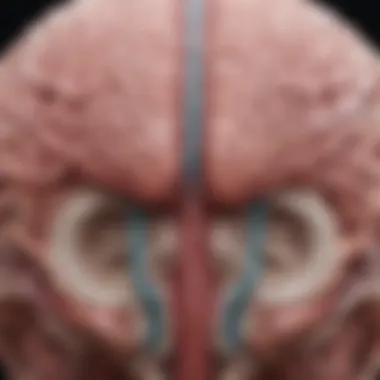Cerebral Meninges Neoplasm: Comprehensive Insights


Article Overview
Purpose of the Article
This article aims to provide a comprehensive understanding of cerebral meninges neoplasms. These tumors arise in the protective membranes surrounding the brain and spinal cord. By exploring various aspects including their classification, pathophysiology, clinical manifestations, diagnostic techniques, and therapeutic strategies, the article serves as a resource for scholars and clinicians.
Relevance to Multiple Disciplines
Cerebral meninges neoplasms intersect various fields such as neurology, oncology, and radiology. Understanding these tumors is crucial not just for medical professionals but also for researchers interested in diseases of the central nervous system. This knowledge aids in diagnosis and treatment planning, which is essential for effective patient care.
Research Background
Historical Context
The study of meninges neoplasms dates back several decades. Early research focused primarily on histopathological identification of tumors. As technology advanced, diagnostic techniques such as MRI and CT scans emerged, enabling more accurate detection and characterization of these neoplasms. Over time, research has expanded into understanding tumor behavior, treatment outcomes, and the importance of early detection.
Key Concepts and Definitions
Cerebral meninges neoplasms refer to a variety of tumors that occur in the meninges, which are the protective layers covering the brain and spinal cord. Key types of these neoplasms include meningiomas, which are the most common, as well as less common forms like diffuse leptomeningeal glioneuronal tumors. Understanding these definitions helps distinguish between different tumor types and their respective clinical implications.
> "A clear understanding of tumor characteristics is vital for accurate diagnosis and effective treatment strategies."
Neurooncology is a specific area of study focusing on tumors in the nervous system, including those that arise in the meninges. This interdisciplinary field draws knowledge from biology, pathology, and clinical medicine. By studying cryosections and performing molecular analyses, researchers aim to unlock the secrets behind tumor malignancies and explore potential therapeutic targets.
In summary, this section sets the stage for the detailed analysis that follows. By exploring the purpose, relevance, and historical context of cerebral meninges neoplasms, readers are prepared to engage with the complex topics of classification, pathophysiology, and treatment options in the upcoming sections.
Preface to Cerebral Meninges Neoplasm
Cerebral meninges neoplasm is a critical area of study within the realms of neurology and oncology. Understanding these neoplasms plays a vital role in diagnosing and treating conditions that can significantly affect the brain's protective layers. These protective membranes are essential for safeguarding the brain and spinal cord, and when tumors develop in this area, the implications can be severe.
This topic holds particular importance due to the impact that cerebral meninges neoplasms can have on patient health, prognosis, and overall quality of life. With a range of tumor types and variable clinical outcomes, a comprehensive exploration is necessary to identify key risk factors, symptoms, and potential treatment options available.
Through the examination of cerebral meninges neoplasms, this article seeks to foster a deeper understanding of their underlying mechanisms, highlight diagnostic advancements, and discuss current therapeutic strategies. The focus will be on not only delineating the characteristics of these tumors but also elucidating the nuances of their management and treatment. Ultimately, a well-rounded grasp of cerebral meninges neoplasms is essential for medical professionals, researchers, and students alike, as these findings can lead to more effective interventions and improved patient outcomes.
Defining Cerebral Meninges
The cerebral meninges are protective membranes covering the brain and spinal cord. These layers include three distinctive parts: the dura mater, the arachnoid mater, and the pia mater. The dura mater is the outermost layer, known for its toughness, while the arachnoid mater sits in the middle, and the pia mater is the innermost, closely adhering to the brain's surface. Each layer has specific functions, including providing structure and protecting against physical impacts.
When discussing neoplasms related to the meninges, it is essential to recognize their significance in the overall architecture of the central nervous system. Meningeal tumors, particularly meningiomas, arise primarily from the tissues of the meninges.
Understanding Neoplasm
A neoplasm, commonly referred to as a tumor, is the result of uncontrolled cell growth. This abnormal proliferation can occur in various tissues and lead to either benign or malignant growths. In the context of cerebral meninges, neoplasms can disrupt normal function, causing a range of neurological symptoms.
Neoplasms in the meninges may arise due to genetic mutations, environmental factors, or prior exposure to radiation. Understanding the mechanisms that contribute to their formation is essential for developing effective treatment options. Comprehensive knowledge of the types, characteristics, and behaviors of these tumors can greatly enhance clinical strategies and improve patient care.
"The exploration of cerebral meninges neoplasms not only encompasses their biological aspects but also their clinical implications, warranting a multi-disciplinary approach for comprehensive understanding."
"The exploration of cerebral meninges neoplasms not only encompasses their biological aspects but also their clinical implications, warranting a multi-disciplinary approach for comprehensive understanding."
As the field continues to evolve, staying abreast of developments in research and treatment is crucial for those involved in or affected by these conditions.
Epidemiology
Understanding the epidemiology of cerebral meninges neoplasms is essential for grasping the impact of these tumors on public health and clinical practice. Epidemiology examines the distribution, patterns, and determinants of health-related states. In the context of cerebral meninges neoplasms, it provides insights into their incidence, prevalence, and risk factors, which are crucial for anticipating healthcare needs and improving treatment strategies.
Incidence and Prevalence
Cerebral meninges neoplasms, particularly meningiomas, represent a significant portion of primary central nervous system tumors. The reported incidence of meningiomas varies; however, statistics suggest an incidence rate ranging from 2 to 8 per 100,000 individuals annually.
Key points regarding incidence and prevalence include:
- Higher prevalence in women: Meningiomas occur approximately two to three times more often in women than in men.
- Age Dependency: The majority of cases arise in individuals aged 40 to 70, with a notable increase in incidence as age advances.
- Geographical Variation: Epidemiological studies demonstrate varying prevalence based on geographical regions, implicating environmental factors.
Understanding these figures is vital. It informs health professionals about how often they may encounter such cases in practice. Additionally, it can guide funding and resources to areas of higher incidence.
Risk Factors
Identifying the risk factors associated with cerebral meninges neoplasms can help in formulating preventive measures and enhancing early detection. Several risk factors have been identified, including:


- Genetic Syndromes: Conditions like neurofibromatosis Type 2 (NF2) are linked to a higher risk of developing meningomas.
- Radiation Exposure: Previous exposure to ionizing radiation, particularly to the head, increases the likelihood of tumor formation.
- Hormonal Influences: Given the predominance of these tumors in women, estrogen and progesterone receptors present in some meningiomas suggest a hormonal influence on tumor growth.
- Other Factors: Though less conclusively linked, obesity and certain head injuries have also been suggested as potential risk factors.
Being aware of these risk factors enables clinicians to better assess patient history and recommend appropriate screening approaches. As more information becomes available, this knowledge can contribute to advancements in treatment strategies and patient prognosis.
"The more we understand the epidemiology, the better equipped we are to provide care and resources to those affected."
"The more we understand the epidemiology, the better equipped we are to provide care and resources to those affected."
Pathophysiology
Pathophysiology plays a crucial role in understanding cerebral meninges neoplasms. This section uncovers the fundamental aspects of how these neoplasms develop and progress within the central nervous system. Exploring the mechanisms at cellular and molecular levels offers insights into clinical manifestations, diagnostic approaches, and potential therapeutic strategies. Understanding the pathophysiology of these tumors allows medical professionals to devise tailored treatment plans, monitor patient progress accurately, and anticipate complications.
Cellular Characteristics of Neoplasms
The cellular characteristics of neoplasms in the meninges are diverse and complex. Meningiomas, the most common type of cerebral meninges neoplasm, originate from arachnoidal cells. These tumors often exhibit distinct histological features. For instance, they may present with varying degrees of cellularity, nuclear atypia, and mitotic activity. Understanding these characteristics helps to classify the tumors accurately and predict their behavior.
In addition to meningiomas, other variants such as atypical and malignant meningiomas exhibit more aggressive features.
- Atypical Meningiomas: These tumors show increased mitotic activity and may invade surrounding tissues.
- Malignant Meningiomas: They often display marked cellular pleomorphism and have a higher likelihood of metastasis.
To further comprehend these tumors, researchers use various techniques like immunohistochemistry to identify specific markers. These markers can help differentiate between tumor types and guide treatment strategies.
Mechanism of Tumor Growth
Tumor growth in cerebral meninges neoplasms is a multifaceted process influenced by genetic abnormalities and external factors. The interplay between tumor cells and the surrounding microenvironment is also significant. Several mechanisms contribute to tumor growth and progression:
- Cell Proliferation: Tumor cells often exhibit uncontrollable growth. This abnormal proliferation is regulated partly by growth factors and signaling pathways.
- Invasion and Metastasis: Depending on the tumor type, neoplasms may invade adjacent brain tissue. Malignant forms are particularly notorious for their ability to metastasize.
- Angiogenesis: Tumors often promote the formation of new blood vessels to sustain their growth. This process is driven by factors like vascular endothelial growth factor (VEGF).
- Cell Survival: Tumor cells engage various survival mechanisms. They often evade the normal apoptotic processes, allowing them to persist and proliferate.
By studying these mechanisms, researchers aim to identify potential targets for therapy, which could improve outcomes for patients diagnosed with cerebral meninges neoplasms. Understanding the pathophysiology of these tumors can pave the way for innovative treatment approaches and better diagnostic tools.
Clinical Manifestations
Understanding the clinical manifestations of cerebral meninges neoplasm is essential for both diagnosis and treatment. Symptoms can vary greatly depending on the tumor's size, location, and type. Recognizing these manifestations allows clinicians to make timely interventions. Early detection can lead to improved outcomes, making the knowledge of symptoms essential for both medical professionals and patients.
Symptoms Associated with Meninges Neoplasm
Symptoms associated with meninges neoplasms often include headaches, seizures, and changes in vision. Headaches may become more frequent or severe and can be persistent. Seizures might occur suddenly, especially in individuals without a previous history of such episodes. Changes in vision, including blurred sight or even loss of sight, raise concern for increased intracranial pressure or direct involvement of visual pathways.
Common symptoms also encompass:
- Nausea and vomiting
- Cognitive changes
- Weakness or numbness in limbs
- Altered mental status
It is crucial for clinicians to inquire about these symptoms during evaluations. Patient history can help pinpoint patterns and enhance diagnostic accuracy.
Neurological Complications
Neurological complications arising from meninges neoplasm can be severe. These complications may include loss of motor skills, speech difficulties, and cognitive impairments. Tumors can exert pressure on critical brain regions, leading to functional deficits. The presence of edema around the tumor can also cause overall brain swelling, which exacerbates symptoms.
Moreover, patients may experience a progressive decline in their quality of life. Ongoing complications may require rehabilitation efforts and supportive care to manage symptoms effectively.
Recognizing and addressing clinical manifestations leads to more targeted therapeutic approaches and improved patient outcomes.
Recognizing and addressing clinical manifestations leads to more targeted therapeutic approaches and improved patient outcomes.
Overall, understanding these clinical manifestations is a vital part of the management process. Knowledge in this area facilitates prompt diagnostics and effective treatment, emphasizing the need for ongoing education and research.
Diagnostic Techniques
In the realm of cerebral meninges neoplasms, diagnostic techniques serve as critical pillars for accurate disease recognition and management decisions. Getting the right diagnosis is essential, as it directly impacts treatment plans and patient outcomes. While symptoms may provide initial insight, advanced diagnostic modalities offer clarity that a mere physical examination cannot. This section will delve into the primary imaging techniques and biopsy procedures utilized in diagnosing neoplasms of the cerebral meninges, detailing their significance, benefits, and specific characteristics.
Imaging Modalities
Imaging modalities provide non-invasive ways to visualize and assess abnormalities in the brain and meninges. They play a crucial role in the initial evaluation of suspected neoplasms. Two primary imaging techniques are widely used in this context: Magnetic Resonance Imaging (MRI) and Computed Tomography (CT) Scan. Each technique offers unique advantages that contribute to diagnosing cerebral meninges neoplasms effectively.
Magnetic Resonance Imaging (MRI)
Magnetic Resonance Imaging (MRI) is renowned for its high-resolution images of soft tissues, making it a preferred choice for evaluating cerebral neoplasms. One of the key characteristics of MRI is its ability to provide detailed images of the brain's anatomy without the need for ionizing radiation. This is particularly advantageous when considering the developing brain in younger patients, where minimizing radiation exposure is critical.
One unique feature of MRI is its capacity to use different sequences, allowing differentiation between tumor types and surrounding structures. For example, T1 and T2-weighted images can highlight various aspects of a tumor's composition. However, MRI is not without its drawbacks. The availability of MRI machines can be limited in certain regions, and the time required for scanning can be a concern, particularly in emergency settings. Despite these disadvantages, the rich detail provided by MRI remains indispensable in diagnosing and managing neoplasms efficiently.
Computed Tomography (CT) Scan


Computed Tomography (CT) scans are another essential imaging tool that aids in diagnosing cerebral meninges neoplasms. One specific aspect of CT scans is their ability to generate rapid images, making them ideal for acute situations where immediate diagnosis is required. This characteristic allows clinicians to make quick assessments, especially in emergency departments.
CT scans are often considered a beneficial choice due to their widespread availability and speed. They are particularly useful for detecting calcifications, hemorrhage, or bony involvement that may not be visible on MRI. An additional unique feature is the ability to perform a CT angiography to evaluate vascular involvement in a neoplasm. Nevertheless, the downside is the exposure to ionizing radiation, which is a significant consideration, especially for younger patients or those requiring multiple imaging studies.
Biopsy Procedures
While imaging provides vital information, it is sometimes necessary to obtain histological samples through biopsy procedures for definitive diagnosis. Biopsies can confirm the presence of neoplastic cells and help determine the type of tumor present. There are various methods for conducting biopsies, including stereotactic biopsies and open surgical biopsies. Stereotactic biopsy is a minimally invasive approach that uses imaging guidance to locate and sample abnormal tissue. This technique is particularly advantageous as it minimizes patient recovery time and reduces surgical risks. However, it may not always provide a large enough sample for a comprehensive histopathological analysis.
On the other hand, open surgical biopsy involves a more invasive procedure where a larger sample is obtained. This method can be beneficial when more extensive tissue evaluation is necessary. Despite its advantages, it carries higher risks, including infection and longer recovery times. Overall, the choice of biopsy method should be guided by the clinical scenario and the specific characteristics of the neoplasm in question.
Types of Cerebral Meninges Neoplasms
Understanding the types of cerebral meninges neoplasms is crucial. This section addresses the various kinds of tumors that can arise in the protective membranes of the brain. By classifying these neoplasms, we gain insight into their behavior, treatment options, and prognosis. This knowledge is vital for both diagnosis and therapy, improving patient outcomes. Recognizing the unique characteristics of each type informs clinicians and researchers alike, enabling better strategies for management.
Meningioma
Meningiomas are the most common type of cerebral meninges neoplasm. They are typically benign and develop from the meninges, the layers of tissue covering the brain and spinal cord. Meningiomas can arise anywhere along the meninges. Their growth can lead to increased intracranial pressure, causing various neurological symptoms.
A key characteristic of meningiomas is their slow growth rate. This often allows for a longer period before significant symptoms appear. Some meningiomas may be incidentally discovered during imaging conducted for other reasons. Surgical resection is often the first line of treatment.
However, the surgery can be complex due to the tumor's location. In some cases, radiotherapy might be recommended after surgery to reduce the risk of recurrence. Furthermore, the prognosis for patients with meningiomas is generally favorable, with high survival rates, especially for benign types.
Other Variants
While meningiomas are prominent, other variants exist that merit discussion. These include atypical meningiomas and malignant meningiomas.
Atypical Meningiomas
Atypical meningiomas form a distinct category within the neoplasms. They exhibit more aggressive behavior compared to typical meningiomas. A notable aspect of atypical meningiomas is their higher rate of recurrence post-surgery. This recurrence makes careful monitoring essential following treatment. Atypical meningiomas also have a higher chance of being symptomatic due to their growth rate and location.
The key characteristic of atypical meningiomas is their histological pattern, which often shows increased cellularity and mitosis. These tumors may be more invasive than their benign counterparts. In this article, recognizing atypical meningiomas is critical as they may require different therapeutic approaches.
Malignant Meningiomas
Malignant meningiomas, also referred to as grade III meningiomas, represent the most aggressive type of this tumor. They possess unique characteristics that distinguish them from benign variants. An essential feature of malignant meningiomas is their rapid growth and propensity to invade surrounding brain tissue. This behavior complicates surgical resection and increases the likelihood of poor outcomes.
Because of their aggressive nature, malignant meningiomas often require a combination of surgical intervention and adjuvant therapies like radiotherapy. The treatment plan for these tumors is more nuanced than for benign types due to their challenging biology. Furthermore, understanding the characteristics of malignant meningiomas is vital for clinicians, as the prognosis may differ significantly from that of benign or atypical meningiomas.
"Recognizing the variety within cerebral meninges neoplasms is essential for effective patient management and tailored treatment protocols."
"Recognizing the variety within cerebral meninges neoplasms is essential for effective patient management and tailored treatment protocols."
This exploration of the types of cerebral meninges neoplasms underscores the diversity and complexity of these tumors. Knowledge of their forms and behavior is essential for clinicians and researchers encountering these cases in practice.
Treatment Approaches
The treatment approaches for cerebral meninges neoplasm are vital for understanding how to manage this type of tumor effectively. These approaches combine knowledge from surgery and other therapeutic methods to enhance patient outcomes. Focusing on treatment is crucial because the variations in tumor type, patient health status, and tumor location can significantly influence how healthcare providers design and implement effective treatment plans.
Surgical Interventions
Surgical intervention remains the cornerstone of treatment for many cerebral meninges neoplasms. The primary aim of surgery is to remove the tumor completely or debulk it effectively if complete excision is not feasible due to surrounding critical structures. Success in surgery can often lead to immediate symptom relief and may prolong survival.
The extent of surgical removal influences prognosis. For instance, total resection of a meningioma, which is a common type of cerebal meninges neoplasm, can lead to optimal outcomes. However, the challenge in surgical procedures often involves the location of the tumor. Tumors that are deeply embedded or adjacent to important neurological structures may present risks during surgery.
Moreover, risks such as bleeding, infection, and neurological deficits necessitate thorough preoperative evaluation and careful postoperative monitoring. Advances in neurosurgical techniques, such as intraoperative imaging, have improved surgical outcomes and minimized risks.
Adjuvant Therapy
Adjuvant therapy includes treatments given in addition to surgery, aimed at further reducing the risk of tumor recurrence or progression. It takes a holistic approach to enhance the effectiveness of initial surgical procedures.
Radiotherapy
Radiotherapy is often used post-surgery to target residual tumor cells that may not have been resected completely. The key characteristic of radiotherapy is its precision in targeting tumor tissue while sparing surrounding healthy brain tissue. This method is particularly beneficial in managing atypical or malignant meningiomas, where the risk of recurrence is higher.
A unique feature of radiotherapy is its ability to deliver high-energy radiation using advanced techniques like stereotactic radiosurgery. This allows for highly focused treatment, reducing damage to surrounding tissues and minimizing side effects. However, potential disadvantages include the need for multiple sessions and the risk of late effects such as radiation necrosis. Nonetheless, the therapeutic advantages often outweigh these risks in many cases.
Chemotherapy
Chemotherapy is less commonly employed in the treatment of cerebral meninges neoplasms compared to other tumor types, primarily due to the unique biological behavior of meningiomas. This method may be useful in treating malignant meningiomas where surgical options are limited or in cases where the tumor is unresectable. The key characteristic of chemotherapy is its systemic approach, targeting cancer cells throughout the body.


One unique feature of chemotherapy is its potential to induce tumor shrinkage and mitigate symptoms associated with larger tumors. However, it often comes with disadvantages such as systemic side effects that can significantly impact the patient's quality of life and may require additional supportive care. As a result, chemotherapy may be considered more selectively, depending on the individual patient's needs and tumor characteristics.
The choice of treatment approaches should always be personalized and discussed thoroughly among healthcare providers and patients to select the most appropriate strategy for each individual case.
The choice of treatment approaches should always be personalized and discussed thoroughly among healthcare providers and patients to select the most appropriate strategy for each individual case.
Prognosis and Survival Rates
Understanding prognosis and survival rates for cerebral meninges neoplasm is crucial for both patients and healthcare providers. It helps in planning the treatment approach and managing patient expectations. Furthermore, it provides insights into the disease's behavior, guiding studies in clinical research and improving therapeutic strategies. By assessing these factors, clinicians can make informed decisions that align closely with the patients’ unique circumstances.
Factors Influencing Prognosis
Several factors influence the prognosis of cerebral meninges neoplasm. Among them, tumor type, location, and size play a significant role. Meningiomas, which are the most common type, generally have a favorable outcome if they are completely resected. Conversely, atypical and malignant meningiomas pose more challenges. They have a higher recurrence rate and often require more aggressive treatment.
Additionally, patient age and overall health can greatly impact prognosis. Younger patients tend to have better outcomes than older individuals. Other relevant factors include:
- Tumor Grade: Higher-grade tumors often indicate a worse prognosis.
- Extent of Resection: Complete surgical removal correlates with improved survival rates.
- Presence of Symptoms: Patients with significant neurological symptoms prior to diagnosis may experience a poorer outcome.
Understanding these variables helps in estimating prognosis and tailoring treatment plans.
Long-Term Outcomes
Long-term outcomes for individuals with cerebral meninges neoplasm vary widely, depending on several factors discussed previously. For instance, the 5-year survival rate for low-grade meningiomas is quite high, reaching up to 90% when fully removed. In contrast, survival rates diminish for high-grade tumors. Patients may also experience long-term effects related to treatment, including cognitive changes or neurological deficits.
Ongoing monitoring is essential even after successful treatment. The risk of recurrence remains significant, especially for atypical and malignant forms. Regular follow-up through imaging can help detect any regrowth early, allowing for prompt intervention.
In summary, understanding prognosis and long-term outcomes for cerebral meninges neoplasm enables clinicians to provide better care, ensuring that treatment is as effective as possible.
"Prognosis is not just about the numbers; it’s about understanding the whole patient and their needs."
"Prognosis is not just about the numbers; it’s about understanding the whole patient and their needs."
Continued research into the biology of these neoplasms will likely lead to improved knowledge of prognosis and better treatment outcomes.
Current Research Trends
Research into cerebral meninges neoplasms is vital in understanding the complex behaviors of these tumors. Current trends reflect a shift towards more innovative and targeted treatment strategies aimed at improving patients' outcomes. This section explores the significance of focusing on novel therapeutics and ongoing clinical trials, highlighting their potential implications for both clinical practice and research methodologies.
Novel Therapeutics
The development of novel therapeutics is crucial in addressing the limitations of traditional treatments for cerebral meninges neoplasms. Researchers are exploring various approaches that focus on the molecular and genetic aspects of tumors.
- Targeted therapies: These are designed to disrupt specific pathways that facilitate tumor growth. Medications like imatinib and everolimus have demonstrated promise in clinical settings, presenting a less toxic option compared to conventional chemotherapy.
- Immunotherapy: The use of immune checkpoint inhibitors, such as pembrolizumab, is gaining traction. This strategy aims to enhance the body’s natural defenses to fight cancer, providing an alternative that could yield better outcomes for patients with aggressive forms of meninges tumors.
- Gene therapy: Investigations into gene-editing technologies, such as CRISPR/Cas9, have marked a new frontier in treatment possibilities. By targeting genetic mutations involved in tumor proliferation, these therapies hold potential for profound impacts on future treatment protocols.
Each of these therapeutics also requires a careful evaluation of effectiveness and safety through rigorous studies, keeping the patient-centered approach at the forefront.
Ongoing Clinical Trials
Clinical trials are essential in the quest for more effective treatments. Ongoing investigations play a pivotal role in translating laboratory findings into clinical applications.
- Phase I Trials: Early trials are assessing the safety and efficacy of new drugs in patients with cerebral meninges neoplasms. These trials help identify the optimal dosing and potential side effects.
- Phase II Trials: These studies focus on the effectiveness of the drugs, providing crucial data that can guide further research. Investigators are particularly examining combinations of existing therapies to enhance response rates.
- Longitudinal Studies: Research into long-term outcomes of various treatment modalities is ongoing. Continuous monitoring will offer insights into survival rates and quality of life for patients over time.
"Research in clinical trials not only aids in finding effective treatments but also helps elucidate the biological behavior of tumors, paving the way for future discoveries."
"Research in clinical trials not only aids in finding effective treatments but also helps elucidate the biological behavior of tumors, paving the way for future discoveries."
Finale
The conclusion section of an article on cerebral meninges neoplasm synthesizes critical findings and highlights the topic's significance. Understanding these neoplasms is crucial for healthcare professionals, researchers, and students. It not only summarizes key insights but also underscores the complexities involved in diagnosis and treatment. In this context, it addresses various factors influencing prognosis, paving the way for better patient outcomes.
Summary of Key Findings
The exploration of cerebral meninges neoplasm reveals several notable findings:
- Diverse Classification: Cerebral meninges neoplasms include various types, such as meningiomas and atypical variants, each with distinct characteristics and treatment implications.
- Clinical Symptoms: Symptoms may vary based on tumor location and size, ranging from headaches to neurological deficits, which can complicate early diagnosis.
- Diagnostic Techniques: Imaging methods like MRI and CT scans are vital in assessing tumor features. Biopsy procedures confirm diagnoses and guide treatment planning.
- Treatment Modalities: Effective treatment often requires a combination of surgical and adjuvant therapies, adaptable to individual patient needs.
Understanding these aspects assists clinicians in establishing effective management strategies, ultimately enhancing patient care.
Understanding these aspects assists clinicians in establishing effective management strategies, ultimately enhancing patient care.
Future Directions in Research
Future research in cerebral meninges neoplasm should focus on several key areas:
- Genetic Insights: Uncovering genetic alterations associated with different tumor types may pave the way for targeted therapies.
- Novel Therapeutics: Investigating new drug candidates and treatment regimens can improve patient outcomes and offer alternatives when traditional therapies fail.
- Longitudinal Studies: Comprehensive studies evaluating long-term care and survival rates can enhance understanding of this condition and inform clinical practices.
- Clinical Trials: Continued support for ongoing clinical trials will facilitate the exploration of innovative treatments and foster collaboration within the medical community.
Developing a deeper understanding of cerebral meninges neoplasms fosters improvement in clinical practices, ensuring that research is continually aligned with patient needs.



